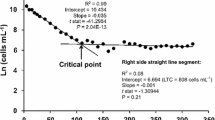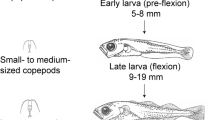Abstract
Larval growth rate and settlement of the European flat oyster Ostrea edulis were experimentally studied as a function of the composition of dietary fatty acids. Diets differing in fatty acid composition were composed by mixtures of the microalgae Isochrysis galbana, Pavlova lutheri and Chaetoceros calcitrans. Fatty acid content in the tissue of the feeding larvae, analyzed by gas chromatography and mass spectrometry, reflected the composition in the diet. Larval growth rate was significantly correlated to the three omega-3 polyunsaturated fatty acids (PUFA) C18:3, C18:4 and C22:6, with minor differences for neutral and polar lipids. No relation between growth rate and the omega-3 PUFA C20:5 was detected, a PUFA often implied as essential for bivalves. It is suggested that naturally occurring variability in fatty acid composition may constrain larval growth. In settlement experiments in both still water and flume flow little substrate selectivity was found for some contrasting substrates. It is concluded that differences in dietary fatty acids may explain as much of settlement success as the variability of substrates.
Similar content being viewed by others
Author information
Authors and Affiliations
Additional information
Received: 12 October 1998 / Accepted: 6 April 1999
Rights and permissions
About this article
Cite this article
Jonsson, P., Berntsson, K., André, C. et al. Larval growth and settlement of the European oyster (Ostrea edulis) as a function of food quality measured as fatty acid composition. Marine Biology 134, 559–570 (1999). https://doi.org/10.1007/s002270050571
Issue Date:
DOI: https://doi.org/10.1007/s002270050571




